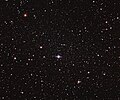Fichier:Carina Dwarf Galaxy.jpg

Taille de cet aperçu : 719 × 600 pixels. Autres résolutions : 288 × 240 pixels | 576 × 480 pixels | 921 × 768 pixels | 1 228 × 1 024 pixels | 2 456 × 2 048 pixels | 3 771 × 3 145 pixels.
Fichier d’origine (3 771 × 3 145 pixels, taille du fichier : 5,64 Mio, type MIME : image/jpeg)
Historique du fichier
Cliquer sur une date et heure pour voir le fichier tel qu'il était à ce moment-là.
| Date et heure | Vignette | Dimensions | Utilisateur | Commentaire | |
|---|---|---|---|---|---|
| actuel | 24 février 2015 à 15:14 |  | 3 771 × 3 145 (5,64 Mio) | FDMS4 | Reverted to version as of 14:03, 28 June 2011. |
| 24 février 2015 à 05:00 |  | 3 768 × 3 144 (5,78 Mio) | SteinsplitterBot | Bot: Image rotated by 180° | |
| 28 juin 2011 à 16:03 |  | 3 771 × 3 145 (5,64 Mio) | Jmencisom |
Utilisation du fichier
Les 2 pages suivantes utilisent ce fichier :
Usage global du fichier
Les autres wikis suivants utilisent ce fichier :
- Utilisation sur af.wikipedia.org
- Utilisation sur ar.wikipedia.org
- Utilisation sur ast.wikipedia.org
- Utilisation sur ca.wikipedia.org
- Utilisation sur de.wikipedia.org
- Utilisation sur el.wikipedia.org
- Utilisation sur en.wikipedia.org
- Utilisation sur es.wikipedia.org
- Utilisation sur fi.wikipedia.org
- Utilisation sur he.wikipedia.org
- Utilisation sur id.wikipedia.org
- Utilisation sur it.wikipedia.org
- Utilisation sur ja.wikipedia.org
- Utilisation sur ko.wikipedia.org
- Utilisation sur mk.wikipedia.org
- Utilisation sur nl.wikipedia.org
- Utilisation sur no.wikipedia.org
- Utilisation sur pl.wikipedia.org
- Utilisation sur pt.wikipedia.org
- Utilisation sur ro.wikipedia.org
- Utilisation sur ru.wikipedia.org
- Utilisation sur si.wikipedia.org
- Utilisation sur sk.wikipedia.org
- Utilisation sur tr.wikipedia.org
- Utilisation sur uk.wikipedia.org
- Utilisation sur vi.wikipedia.org
- Utilisation sur www.wikidata.org
